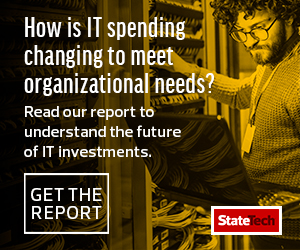Cybersecurity Concerns Driven by a Need to Protect Citizen Data
State and local government agencies are no strangers to cybersecurity threats, including ransomware and denial-of-service attacks. They are also on high alert because they need to protect a wide range of citizen data, including personally identifiable information and health data. Unsurprisingly, according to CDW and IDG survey findings, 69 percent of state or local government respondents cite government compliance or regulatory mandates as the top reason they are making cybersecurity investments. And 42 percent say they are investing in risk mitigation because of what they are learning about cyber risk from industry-related information sources.
How will state and local governments tackle IT security challenges? According to the survey, 52 percent of respondents cite increasing security awareness and staff training as a top risk mitigation objective. Another 43 percent cite improving their understanding of external threats, via threat intelligence, for example.
READ MORE: Find out how to overcome Big Data challenges.
Data Analytics Can Drive Workplace Productivity in Government
The massive volume of data state and local governments have to protect also means that they have a large reservoir of data they can leverage to glean insights and improve services. Increased investment in data analytics is seen by state and local IT leaders as one way to enhance user productivity.
CDW and IDG survey findings show that 62 percent of state or local government respondents see analytics software as a top IT investment priority to improve workplace productivity, flexibility and engagement. Meanwhile, 52 percent prioritize productivity software (documents, spreadsheets, presentations).
Using analytics, state and local agencies can turn data into valuable insights that can then make workers more productive. According to the survey, 48 percent of state or local government respondents say extracting more value from their data is the main way they plan to use technology to improve workplace productivity. The survey reveals that 37 percent cite increased investment in automation technology as the path to boost productivity.
MORE FROM STATETECH: Discover how to accurately estimate cloud migration costs.
Cloud Is Seen as Necessary, but Costs Must Be Managed
To fully leverage data analytics and other modern applications, state and local governments will need to invest in modern IT infrastructure. Cloud investments are likely going to be a major part of that.
According to the CDW and IDG survey, state or local government respondents expect Software as a Service to make up 29 percent of their total IT infrastructure two years from now, and expect Infrastructure as a Service to make up 22 percent. The survey further reveals that respondents expect 21 percent of their environment to be Platform as a Service in two years and 27 percent to be noncloud environments.
Beyond exploring planned infrastructure investments, the CDW and IDG survey shows state and local agencies are also concerned about costs. That is especially pertinent given that many agencies are likely going to have to cut their budgets in the near future due to deteriorating economic conditions and falling revenues. The survey found that 47 percent of state or local government respondents view IT cost management as their top priority over the next two years to modernize technology infrastructure and meet their business objectives. Meanwhile, 42 percent cite cloud monitoring and management as their main priority.
LEARN MORE: Find out how digital servcies teams can improve the citizen experience.
Data and Regulations Drive Changing Citizen Experiences
Improving the citizen experience is critical for state and local governments. Those agencies are most connected to how citizens live their daily lives — issuing permits, delivering municipal services, offering public health assistance, providing public safety and more.
State and local governments are pushing to digitize more services and processes and make them more efficient. That, in turn, can help improve the citizen experience. The CDW and IDG survey findings reveal that 63 percent of state or local government respondents plan to use data and analytics technology to improve the citizen experience. Meanwhile, 35 percent say they will invest in mobile apps to achieve that goal.
According to the survey, 44 percent of state or local respondents cite a changing regulatory and compliance environment — for example, data protection rules — as a top driver of investments to transform the customer experience. The survey data also shows that 39 percent of respondents say these investments are driven by the fact citizens are more empowered and demand both a seamless user experiences across all touchpoints and real-time access to data.











